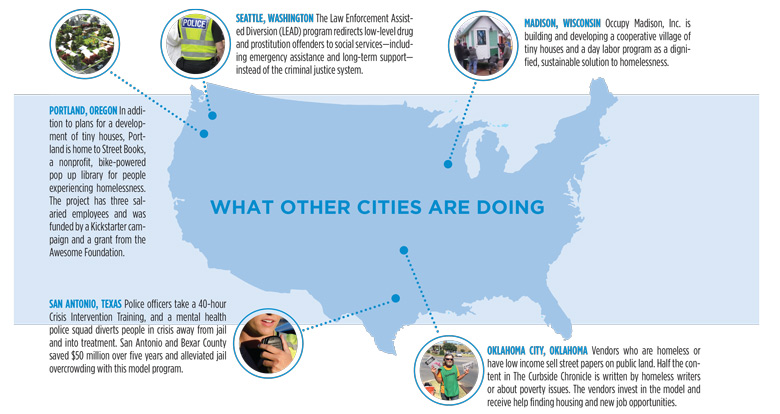Outside the box
Downtown development is casting a spotlight on homelessness, but what are we doing about it?
(page 3 of 5)

Tulsa's response
Recent local responses to homelessness include imposing curfews in downtown parks, removing places to sit and posting signs about panhandlers.
Carlos Moreno—president of TulsaNow, an advocacy group for smart, sustainable development and preservation of green space in Tulsa—said such policies set the tone for our community. Creating park curfews and removing park benches robs all Tulsans—including people without homes—of the chance to enjoy public spaces.
“We’ve tried building fences around parks, we’ve tried imposing a curfew, we’ve tried putting up mean and dehumanizing signs, and we’ve tried taking away benches,” Moreno said in an email to the Voice. “None of these efforts are compassionate. All of them are punitive in nature and instruct citizens, in turn, to be mean, cold, and distant. If that’s not the city we want, we need to think of solutions that reflect compassion.”
— Carlos Moreno, TulsaNow president
The city has hired three security officers—called Public Safety Ambassadors—to patrol the Inner Dispersal Loop on behalf of the Downtown Coordinating Council. In addition to reporting trash, vandalism and criminal behavior, they respond to low-danger concerns in order to make business owners and patrons feel safe and supported. The PSAs appear to have a good relationship with the Tulsa Police Department, but it’s hard to say whether these officers are making our streets safer or just marginalizing homeless people and pushing them out of downtown.
Experts in urban design and public health emphasize that the built environment reflects a community’s values. Forcing homeless people out of public spaces—the “out of sight, out of mind” philosophy—further marginalizes a vulnerable population, pushes them into other areas of the city and raises questions about our collective compassion, creativity and culture.
Tanya Moore directs finance and administration at Iron Gate, downtown Tulsa’s soup kitchen and emergency grocery pantry. Moore said Tulsa laid the groundwork for the current conflict with homelessness years ago when most homeless-serving agencies were pushed into the then-undesirable downtown area.
“Truthfully, I think you can tie it back to the race riots and the healing that didn’t happen,” Moore said. “We have yet to fully accept, as a society and in Tulsa, and a culture, the damage that was done and created. We are very comfortable in Tulsa having our little ghettos and our don’t cross the tracks, and homeless people defy that, because they can walk anywhere.”
We have a lot to learn, but some bright spots are emerging in Tulsa. Several local programs—A Way Home for Tulsa, HUD Continuum of Care Homeless Program, Pathways and others—are working to implement Housing First initiatives. And in May, the city’s Special Services Court held its first jail diversion docket for people facing homelessness or extenuating circumstances. The court is championed by Chief City Prosecutor Bob Garner, and it’s a promising step toward more effective practices. Once someone is placed on the Special Services Docket, that person works with a case manager to complete agreed-upon goals. As long as certain conditions are met—attendance at court dates and achieving set goals, the case is dismissed. The process usually takes about 6 months to complete, but it saves people from jail time and costly court fines and provides a path out of the cycle. The program gives opportunity, responsibility, and autonomy to people often denied such privileges by the system.


.jpg)
.jpg)
